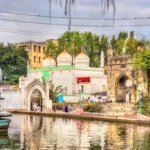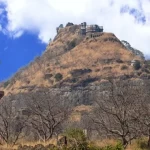Embark on a divine journey to the 108 Shakti Piths, sacred sites where Goddess Shakti's power is revered, guiding devotees on a spiritual quest.
Introduction:
The concept of Shakti Piths holds a prominent place in Hindu History, symbolizing the essence of feminine power and divinity. According to ancient scriptures, these 108 revered sites are believed to be the spots where parts of Goddess Sati's body fell after her self-immolation in the sacrificial fire. Each Shakti Pith is considered a sacred abode of Goddess Shakti, representing her different aspects and attributes. In this blog, we embark on a spiritual odyssey as we explore all 108 Shakti Piths, unraveling their unique significance, history, and cultural importance.
Kamakhya Peeth (Assam, India):
Located atop the Nilachal Hill in Guwahati, Assam, Kamakhya Peeth is believed to be the place where the womb and genitals of Goddess Sati fell. It is one of the most prominent Shakti Piths and hosts the famous Kamakhya Temple, a symbol of fertility and feminine energy.
Kalighat Peeth (West Bengal, India):
Situated in Kolkata, West Bengal, Kalighat Peeth marks the spot where the right toe of Goddess Sati fell. The Kalighat Kali Temple, a revered shrine, attracts countless devotees seeking the blessings of Goddess Kali, the fierce form of Shakti.
Jwalamukhi Peeth (Himachal Pradesh, India):
In the picturesque hills of Kangra, Himachal Pradesh, lies Jwalamukhi Peeth, where the tongue of Goddess Sati is believed to have fallen. The temple here features natural gas-fueled flames that have burned for centuries, signifying the eternal presence of the Goddess.
Ambaji Peeth (Gujarat, India):
At the foothills of the Aravalli Range in Gujarat, Ambaji Peeth commemorates the spot where the heart of Goddess Sati fell. The Ambaji Temple, an ancient pilgrimage site, witnesses a constant stream of devotees seeking solace and fulfillment.
Vindhyavasini Peeth (Uttar Pradesh, India):
Nestled in Vindhyachal, Uttar Pradesh, Vindhyavasini Peeth is where the earrings of Goddess Sati are said to have fallen. The Vindhyavasini Temple stands as a symbol of divine grace and maternal protection.
Chamunda Peeth (Himachal Pradesh, India):
Located near Dharamshala in Himachal Pradesh, Chamunda Peeth represents the place where the hair of Goddess Sati fell. The Chamunda Devi Temple, set amidst picturesque surroundings, is a site of profound spiritual significance.
Kanyakumari Peeth (Tamil Nadu, India):
At the southernmost tip of India, in Kanyakumari, Tamil Nadu, lies Kanyakumari Peeth. This sacred spot is where the back part of Goddess Sati's body is believed to have fallen. The Kanyakumari Temple attracts pilgrims from far and wide, offering a breathtaking view of the confluence of the Arabian Sea, the Bay of Bengal, and the Indian Ocean.
Bahula Peeth (West Bengal, India):
In Ketugram, West Bengal, Bahula Peeth marks the location where the left arm of Goddess Sati is believed to have fallen. The Bahula Devi Temple stands as a symbol of feminine strength and protection.
Manasa Peeth (West Bengal, India):
Situated in Sagardwip, West Bengal, Manasa Peeth honors the spot where the mind of Goddess Sati is said to have fallen. The Manasa Devi Temple is revered by devotees seeking mental peace and tranquility.
Ujjaini Peeth (Madhya Pradesh, India):
In Ujjain, Madhya Pradesh, Ujjaini Peeth commemorates the place where the upper lip of Goddess Sati fell. The Mahakaleshwar Temple, a major Jyotirlinga shrine, stands as a powerful symbol of the eternal cycle of creation and destruction.
Prayaga Peeth (Uttar Pradesh, India):
Also known as Allahabad, Prayaga is the confluence of the holy rivers Ganga, Yamuna, and Saraswati. This is where the fingers of Goddess Sati are said to have fallen. The site holds immense significance during the Kumbh Mela, one of the largest religious gatherings in the world.
Chintpurni Peeth (Himachal Pradesh, India):
Nestled in the Una district of Himachal Pradesh, Chintpurni Peeth is where the feet of Goddess Sati are believed to have fallen. The Chintpurni Temple attracts pilgrims seeking relief from worries and mental distress.
Alampur Peeth (Telangana, India):
Situated in Alampur, Telangana, Alampur Peeth is where the upper teeth of Goddess Sati are said to have fallen. The Jogulamba Temple, dedicated to Goddess Jogulamba, is one of the 18 Shakti Peethas.
Bhimashankar Peeth (Maharashtra, India):
Located near Pune, Maharashtra, Bhimashankar Peeth is where the eyebrows of Goddess Sati are believed to have fallen. The Bhimashankar Jyotirlinga Temple is a significant pilgrimage site dedicated to Lord Shiva.
Guhyeshwari Peeth (Nepal):
In Kathmandu, Nepal, Guhyeshwari Peeth is where the lower part of the throat of Goddess Sati fell. The Guhyeshwari Temple holds profound importance in both Hindu and Buddhist traditions.
Viraja Peeth (Odisha, India):
Located in Jajpur, Odisha, Viraja Peeth marks the spot where the navel of Goddess Sati is believed to have fallen. The Viraja Temple is revered as one of the 18 Maha Shakti Peethas.
Bhairavi Peeth (Maharashtra, India):
In Ambejogai, Maharashtra, Bhairavi Peeth represents the location where the 'Yoni' (reproductive organ) of Goddess Sati is said to have fallen. The Bhairavnath Temple is a significant pilgrimage site in the region.
Kolhapur Peeth (Maharashtra, India):
Situated in Kolhapur, Maharashtra, Kolhapur Peeth is where the left leg of Goddess Sati fell. The Mahalakshmi Temple, a Shakti Peeth, is one of the revered Asthavinayak temples dedicated to Lord Ganesha.
Katyayani Peeth (Uttar Pradesh, India):
Located in Vrindavan, Uttar Pradesh, Katyayani Peeth commemorates the place where the ringlets of hair of Goddess Sati fell. The Katyayani Temple holds immense significance during Navratri celebrations.
Kalika Peeth (Bangladesh):
Situated in Birbhum district, Bangladesh, Kalika Peeth marks the spot where the right toes of Goddess Sati are believed to have fallen. The Kalika Temple attracts devotees seeking blessings and protection.
Kamgiri Peeth (Assam, India):
Located in Kajalgaon, Assam, Kamgiri Peeth is believed to be the place where the right shoulder of Goddess Sati fell. The Kamakhya Temple complex houses this revered Shakti Peeth.
Kankalitala Peeth (West Bengal, India):
In Birbhum district, West Bengal, Kankalitala Peeth marks the spot where the bones of Goddess Sati are said to have fallen. The Kankalitala Temple is an important pilgrimage site for devotees.
Panchsagar Peeth (Uttarakhand, India):
Situated in Uttarakhand, Panchsagar Peeth represents the location where the "Khanda" (sword) of Goddess Sati is believed to have fallen. It is a remote and less-explored pilgrimage site.
Karavira Peeth (Bangladesh):
In Patuakhali district, Bangladesh, Karavira Peeth marks the spot where the right ear of Goddess Sati fell. The Karavira Devi Temple is a revered site for devotees.
Karnat Peeth (Jharkhand, India):
Located in Rajmahal Hills, Jharkhand, Karnat Peeth is where the earrings of Goddess Sati are believed to have fallen. The Karnat Temple is a significant site for Hindu devotees.
Odra Peeth (Odisha, India):
In Odisha, Odra Peeth marks the place where the navel of Goddess Sati is believed to have fallen. The Odra Devi Temple attracts pilgrims from across the region.
Dakshayani Peeth (Bihar, India):
Situated in Darbhanga, Bihar, Dakshayani Peeth represents the location where the bride price of Goddess Sati is said to have fallen. The Dakshayani Temple is a revered site for devotees.
Hinglaj Peeth (Pakistan):
Located in Balochistan, Pakistan, Hinglaj Peeth marks the place where the head of Goddess Sati is believed to have fallen. The Hinglaj Mata Temple attracts pilgrims from both India and Pakistan.
Nandikeshwari Peeth (Chhattisgarh, India):
In Chhattisgarh, Nandikeshwari Peeth is where the necklace of Goddess Sati is said to have fallen. The Nandikeshwari Temple holds religious importance for devotees.
Jharkhandika Peeth (Jharkhand, India):
Situated in Ramgarh, Jharkhand, Jharkhandika Peeth represents the place where the right breast of Goddess Sati fell. The Jharkhandika Temple is an important site for local devotees.
Sriparvat Peeth (Himachal Pradesh, India):
Located near Mandi, Himachal Pradesh, Sriparvat Peeth is where the neck of Goddess Sati is believed to have fallen. The Sriparvat Devi Temple is a sacred site for devotees.
Gandaki Peeth (Nepal):
Situated in Pokhara, Nepal, Gandaki Peeth is believed to be the location where the breast of Goddess Sati fell. The Gandaki Temple holds religious importance in Nepal.
Shrinkhala Peeth (Nepal):
In Shringeri, Nepal, Shrinkhala Peeth marks the spot where the anklet of Goddess Sati is said to have fallen. The Shrinkhala Devi Temple attracts pilgrims from the region.
Purnagiri Peeth (Uttarakhand, India):
Located in Pithoragarh district, Uttarakhand, Purnagiri Peeth represents the place where the navel of Goddess Sati is believed to have fallen. The Purnagiri Temple is a significant pilgrimage site.
Attahas Peeth (Bangladesh):
In Shyamnagar Upazila, Bangladesh, Attahas Peeth is where the lower lip of Goddess Sati fell. The Attahas Devi Temple is an important site for Hindu devotees.
Bimala Peeth (Puri, India):
Situated in Puri, Odisha, Bimala Peeth represents the location where the feet of Goddess Sati are believed to have fallen. The Bimala Temple is an integral part of the Jagannath Temple complex.
Preta Shila Peeth (Kurukshetra, India):
Located in Kurukshetra, Haryana, Preta Shila Peeth is where the "Preta Shila" (shoulder) of Goddess Sati is said to have fallen. The Preta Shila Temple is a sacred site for devotees.
Bahairav Peeth (Bihar, India):
In Muzaffarpur, Bihar, Bahairav Peeth marks the place where the ringlets of hair of Goddess Sati fell. The Bahairav Temple holds religious importance in the region.
Vaishno Devi Peeth (Jammu and Kashmir, India):
Situated in the Trikuta Mountains, Jammu and Kashmir, Vaishno Devi Peeth is believed to be the location where the right arm of Goddess Sati fell. The Vaishno Devi Temple is one of the most visited pilgrimage sites in India.
Ugra Tara Peeth (Bangladesh):
Located in Comilla district, Bangladesh, Ugra Tara Peeth is where the "Ugra Tara" (angry form of Tara) is believed to have manifested. The Ugra Tara Temple holds religious significance for devotees.
Rambha Peeth (Assam, India):
In Kamrup district, Assam, Rambha Peeth marks the spot where the left arm of Goddess Sati fell. The Rambha Temple is revered as one of the 51 Shakti Peethas.
Jayanti Peeth (Nepal):
Located in Nepal, Jayanti Peeth is believed to be the place where the right thigh of Goddess Sati fell. The Jayanti Devi Temple attracts devotees from the region.
Bhawanipur Peeth (Bangladesh):
In Bangladesh, Bhawanipur Peeth represents the place where the left leg of Goddess Sati is said to have fallen. The Bhawanipur Devi Temple is an important site for devotees.
Prabhas Peeth (Gujarat, India):
Situated in Veraval, Gujarat, Prabhas Peeth marks the location where the stomach of Goddess Sati is believed to have fallen. The Prabhas Patan Temple is revered as one of the 12 Jyotirlinga shrines.
Kireet Peeth (Pakistan):
Located in Lahore, Pakistan, Kireet Peeth is where the crown of Goddess Sati is said to have fallen. The Kireet Temple attracts pilgrims from both India and Pakistan.
Varanasi Peeth (Uttar Pradesh, India):
In Varanasi, Uttar Pradesh, Varanasi Peeth is believed to be the location where the "Kamandalu" (water pot) of Goddess Sati fell. The Varanasi Temple holds immense significance in Hinduism.
Karaveer Peeth (Maharashtra, India):
Situated in Kolhapur, Maharashtra, Karaveer Peeth represents the place where the right toe of Goddess Sati is believed to have fallen. The Karaveer Temple holds religious importance for devotees.
Lanka Peeth (Sri Lanka):
Located in Sri Lanka, Lanka Peeth is where the "Aruna Shila" (nose ring) of Goddess Sati is said to have fallen. The Lanka Devi Temple holds religious significance for devotees.
Pashupatinath Peeth (Nepal):
In Kathmandu, Nepal, Pashupatinath Peeth is believed to be the location where the "Pashupati" form of Lord Shiva manifested. The Pashupatinath Temple is one of the holiest Shiva temples in the world.
Hingula Peeth (Odisha, India):
Situated in Baluchari, Odisha, Hingula Peeth marks the place where the left foot of Goddess Sati is believed to have fallen. The Hingula Temple attracts devotees seeking blessings and protection.
Prayag Peeth (Uttar Pradesh, India):
Located in Prayagraj, Uttar Pradesh, Prayag Peeth is where the fingers of Goddess Sati are said to have fallen. The site holds immense significance during the Kumbh Mela, one of the largest religious gatherings in the world.
Chandrakanta Peeth (Jharkhand, India):
In Bhagalpur, Jharkhand, Chandrakanta Peeth represents the location where the "Chandrakanta" form of Goddess Shakti manifested. The Chandrakanta Temple is an important site for devotees.
Devikothi Peeth (Nepal):
Situated in Nepal, Devikothi Peeth marks the spot where the "Devikothi" (seat of the goddess) is believed to have manifested. The Devikothi Temple is revered by devotees.
Mithila Peeth (Nepal):
Located in Janakpur, Nepal, Mithila Peeth represents the place where the "Sannihitakshi" form of Goddess Shakti manifested. The Mithila Temple holds religious importance in the region.
Bhimakali Peeth (Himachal Pradesh, India):
In Sarahan, Himachal Pradesh, Bhimakali Peeth marks the spot where the "Bhima Kali" form of Goddess Shakti is believed to have manifested. The Bhimakali Temple attracts pilgrims from the region.
Siddha Peeth (West Bengal, India):
Situated in Bahula, West Bengal, Siddha Peeth represents the location where the left ankle of Goddess Sati is said to have fallen. The Siddha Devi Temple is an important site for devotees.
Vyaghrapada Peeth (West Bengal, India):
In Chandrakona, West Bengal, Vyaghrapada Peeth marks the place where the "Vyaghrapada" (tiger claw) of Goddess Sati is believed to have fallen. The Vyaghrapada Temple is a sacred site for devotees.
Gauri Peeth (Bangladesh):
Located in Bhairab, Bangladesh, Gauri Peeth represents the spot where the left "Pat" (foot) of Goddess Sati fell. The Gauri Devi Temple is revered by Hindu devotees.
Nainativu Peeth (Sri Lanka):
Situated in Sri Lanka, Nainativu Peeth is believed to be the location where the "Naina" (eyes) of Goddess Sati are said to have fallen. The Nainativu Nagapooshani Amman Temple holds religious significance for devotees.
Naina Peeth (Bangladesh):
In Jessore, Bangladesh, Naina Peeth marks the place where the "Naina" (eyes) of Goddess Sati fell. The Naina Devi Temple is an important site for devotees.
Vibhash Peeth (Bangladesh):
Located in Barguna, Bangladesh, Vibhash Peeth represents the spot where the "Vibhash" form of Goddess Shakti is believed to have manifested. The Vibhash Devi Temple holds religious importance for devotees.
Mithila Peeth (Bihar, India):
Situated in Sitamarhi, Bihar, Mithila Peeth represents the place where the "Mithila" form of Goddess Shakti is said to have manifested. The Mithila Temple is revered by devotees.
Vaishnavi Peeth (Uttarakhand, India):
In Kedarnath, Uttarakhand, Vaishnavi Peeth marks the location where the "Vaishnavi" form of Goddess Shakti manifested. The Vaishnavi Devi Temple is an integral part of the Kedarnath Temple complex.
Vishalakshi Peeth (Varanasi, India):
Located in Varanasi, Uttar Pradesh, Vishalakshi Peeth represents the spot where the "Vishalakshi" form of Goddess Shakti is believed to have manifested. The Vishalakshi Temple is revered by devotees.
Varahi Peeth (Bangladesh):
In Sunamganj district, Bangladesh, Varahi Peeth is where the left anklet of Goddess Sati is said to have fallen. The Varahi Temple holds religious importance for devotees.
Ekamrakshetra Peeth (Odisha, India):
Situated in Bhubaneswar, Odisha, Ekamrakshetra Peeth marks the location where the "Ekamra" form of Goddess Shakti is believed to have manifested. The Ekamrakshetra Temple is an important pilgrimage site.
Panch Peeth (Bangladesh):
Located in Rajbari district, Bangladesh, Panch Peeth represents the spot where the "Panch" (forehead) of Goddess Sati is believed to have fallen. The Panch Devi Temple holds religious significance for devotees.
Pashana Peeth (Uttar Pradesh, India):
In Munger, Bihar, Pashana Peeth is where the "Pashana" (sacrificial altar) of Goddess Sati is said to have manifested. The Pashana Devi Temple is revered by devotees.
Shravani Peeth (Jharkhand, India):
Situated in Deoghar, Jharkhand, Shravani Peeth represents the place where the "Shravani" form of Goddess Shakti is believed to have manifested. The Shravani Devi Temple attracts pilgrims during the Shravan month.
Purneshwari Peeth (Bangladesh):
Located in Sylhet, Bangladesh, Purneshwari Peeth marks the location where the "Purneshwari" form of Goddess Shakti is believed to have manifested. The Purneshwari Devi Temple is revered by devotees.
Kurukshetra Peeth (Haryana, India):
In Kurukshetra, Haryana, Kurukshetra Peeth represents the spot where the "Kurukshetra" form of Goddess Shakti is said to have manifested. The Kurukshetra Temple holds religious importance for devotees.
Vibhas Peeth (Bangladesh):
Situated in Nabiganj Upazila, Bangladesh, Vibhas Peeth marks the place where the "Vibhas" form of Goddess Shakti is believed to have manifested. The Vibhas Devi Temple holds religious significance for devotees.
Jalandhar Peeth (Punjab, India):
Located in Jalandhar, Punjab, Jalandhar Peeth represents the location where the "Jalandhar" form of Goddess Shakti is said to have manifested. The Jalandhar Temple is an important site for devotees.
Magadha Peeth (Bihar, India):
In Munger, Bihar, Magadha Peeth marks the location where the "Magadha" form of Goddess Shakti is believed to have manifested. The Magadha Devi Temple is revered by devotees.
Chhattisgarh Peeth (Chhattisgarh, India):
Situated in Chattisgarh, Chhattisgarh Peeth represents the place where the "Chhattisgarh" form of Goddess Shakti is said to have manifested. The Chhattisgarh Temple is revered by devotees.
Trishul Peeth (Nepal):
Located in Kathmandu, Nepal, Trishul Peeth is where the "Trishul" (trident) of Lord Shiva is believed to have fallen. The Trishul Temple holds religious importance in Nepal.
Pushpagiri Peeth (Bangladesh):
In Moulvibazar district, Bangladesh, Pushpagiri Peeth marks the spot where the "Pushpagiri" form of Goddess Shakti is said to have manifested. The Pushpagiri Devi Temple holds religious significance for devotees.
Chattagram Peeth (Bangladesh):
Situated in Chittagong, Bangladesh, Chattagram Peeth represents the location where the "Chattagram" form of Goddess Shakti is believed to have manifested. The Chattagram Temple is an important site for devotees.
Choti Peeth (Bangladesh):
Located in Sherpur district, Bangladesh, Choti Peeth marks the place where the "Choti" (mangal sutra) of Goddess Sati is said to have fallen. The Choti Devi Temple holds religious importance for devotees.
Ratnavali Peeth (Bangladesh):
Situated in Dinajpur district, Bangladesh, Ratnavali Peeth represents the spot where the "Ratnavali" form of Goddess Shakti is believed to have manifested. The Ratnavali Devi Temple is revered by devotees.
Shondesh Peeth (Bangladesh):
In Rajshahi, Bangladesh, Shondesh Peeth marks the location where the "Shondesh" (headband) of Goddess Sati is said to have fallen. The Shondesh Devi Temple holds religious importance for devotees.
Ramgiri Peeth (Chhattisgarh, India):
Located in Dongargarh, Chhattisgarh, Ramgiri Peeth represents the place where the "Ramgiri" form of Goddess Shakti is believed to have manifested. The Ramgiri Temple is revered by devotees.
Simhachalam Peeth (Andhra Pradesh, India):
In Visakhapatnam, Andhra Pradesh, Simhachalam Peeth marks the location where the "Simhachalam" form of Lord Vishnu is believed to have manifested. The Simhachalam Temple is an important pilgrimage site.
Devikarumari Peeth (Bangladesh):
Situated in Jessore district, Bangladesh, Devikarumari Peeth represents the spot where the "Devikarumari" form of Goddess Shakti is said to have manifested. The Devikarumari Devi Temple holds religious significance for devotees.
Devikpatan Peeth (Nepal):
Located in Nepal, Devikpatan Peeth marks the place where the "Devikpatan" form of Goddess Shakti is believed to have manifested. The Devikpatan Temple is revered by devotees.
Nilgiri Peeth (Bangladesh):
In Rangamati district, Bangladesh, Nilgiri Peeth represents the location where the "Nilgiri" form of Goddess Shakti is said to have manifested. The Nilgiri Devi Temple holds religious importance for devotees.
Bhubaneshwar Peeth (Bangladesh):
Situated in Dhaka district, Bangladesh, Bhubaneshwar Peeth marks the spot where the "Bhubaneshwar" form of Goddess Shakti is believed to have manifested. The Bhubaneshwar Temple is revered by devotees.
Jeshoreshwari Peeth (Bangladesh):
Located in Jessore district, Bangladesh, Jeshoreshwari Peeth is believed to be the location where the "Jeshoreshwari" form of Goddess Shakti is said to have manifested. The Jeshoreshwari Devi Temple holds religious significance for devotees.
Kireetgiri Peeth (Bangladesh):
In Chandpur district, Bangladesh, Kireetgiri Peeth represents the place where the "Kireetgiri" form of Goddess Shakti is believed to have manifested. The Kireetgiri Devi Temple is revered by devotees.
Kalmadhav Peeth (Chhattisgarh, India):
Situated in Raipur, Chhattisgarh, Kalmadhav Peeth marks the location where the "Kalmadhav" form of Goddess Shakti is said to have manifested. The Kalmadhav Temple is an important site for devotees.
Sugandha Peeth (Bangladesh):
Located in Rajshahi district, Bangladesh, Sugandha Peeth represents the spot where the "Sugandha" form of Goddess Shakti is believed to have manifested. The Sugandha Devi Temple holds religious importance for devotees.
Panjipath Peeth (Bangladesh):
In Satkhira district, Bangladesh, Panjipath Peeth marks the place where the "Panjipath" form of Goddess Shakti is said to have manifested. The Panjipath Devi Temple is an important site for devotees.
Madhobgiri Peeth (Bangladesh):
Situated in Bogra district, Bangladesh, Madhobgiri Peeth represents the location where the "Madhobgiri" form of Goddess Shakti is believed to have manifested. The Madhobgiri Devi Temple is revered by devotees.
Jwala Peeth (Jammu and Kashmir, India):
Located in Jammu and Kashmir, Jwala Peeth is where the "Jwala" form of Goddess Shakti is said to have manifested. The Jwala Devi Temple is a significant pilgrimage site.
Ambika Peeth (Gujarat, India):
Situated in Jagat, Gujarat, Ambika Peeth marks the spot where the "Ambika" form of Goddess Shakti is believed to have manifested. The Ambika Devi Temple is revered by devotees.
Guptkashi Peeth (Uttarakhand, India):
In Rudraprayag district, Uttarakhand, Guptkashi Peeth represents the location where the "Guptkashi" form of Lord Shiva is said to have manifested. The Guptkashi Temple is an important pilgrimage site.
Manivedika Peeth (Bangladesh):
Located in Dhaka district, Bangladesh, Manivedika Peeth is believed to be the place where the "Manivedika" form of Goddess Shakti is said to have manifested. The Manivedika Devi Temple holds religious significance for devotees.
Bhuteshwari Peeth (Bangladesh):
Situated in Comilla district, Bangladesh, Bhuteshwari Peeth represents the spot where the "Bhuteshwari" form of Goddess Shakti is believed to have manifested. The Bhuteshwari Devi Temple is revered by devotees.
Pashupata Peeth (Bangladesh):
In Bagerhat district, Bangladesh, Pashupata Peeth marks the location where the "Pashupata" form of Lord Shiva is said to have manifested. The Pashupata Temple is an important pilgrimage site.
Tripura Sundari Peeth (Bangladesh):
Located in Moulvibazar district, Bangladesh, Tripura Sundari Peeth represents the place where the "Tripura Sundari" form of Goddess Shakti is believed to have manifested. The Tripura Sundari Devi Temple holds religious significance for devotees.
Bharatidesh Peeth (Bangladesh):
Situated in Mymensingh district, Bangladesh, Bharatidesh Peeth marks the spot where the "Bharatidesh" form of Goddess Shakti is said to have manifested. The Bharatidesh Devi Temple is an important site for devotees.
Jaleshwar Peeth (Bangladesh):
In Sylhet district, Bangladesh, Jaleshwar Peeth represents the location where the "Jaleshwar" form of Goddess Shakti is believed to have manifested. The Jaleshwar Devi Temple is revered by devotees.
Samanta Peeth (Bangladesh):
Located in Sylhet district, Bangladesh, Samanta Peeth is believed to be the place where the "Samanta" form of Goddess Shakti is said to have manifested. The Samanta Devi Temple holds religious significance for devotees.
Bhramari Peeth (Bangladesh):
Situated in Barishal district, Bangladesh, Bhramari Peeth marks the spot where the "Bhramari" form of Goddess Shakti is believed to have manifested. The Bhramari Devi Temple is revered by devotees.
Shankari Peeth (Bangladesh):
In Cox's Bazar, Bangladesh, Shankari Peeth represents the location where the "Shankari" form of Goddess Shakti is said to have manifested. The Shankari Devi Temple holds religious importance for devotees.
Bhairavakona Peeth (Andhra Pradesh, India):
Located in Andhra Pradesh, Bhairavakona Peeth marks the place where the "Bhairavakona" form of Goddess Shakti is believed to have manifested. The Bhairavakona Temple is revered by devotees.
Sugandhak Peeth (Nepal):
Situated in Nepal, Sugandhak Peeth represents the spot where the "Sugandhak" form of Goddess Shakti is said to have manifested. The Sugandhak Temple is revered by devotees.
Prabhasa Peeth (Gujarat, India):
In Somnath, Gujarat, Prabhasa Peeth marks the location where the "Prabhasa" form of Lord Shiva is believed to have manifested. The Prabhasa Temple is an important pilgrimage site.
Conclusion:
The 108 Shakti Piths stand as a testimony to the immense spiritual significance and cultural richness of Hindu mythology. Each Shakti Peeth holds a unique story, symbolizing the divine power and energy of Goddess Shakti. These sacred sites continue to attract devotees from all walks of life, seeking blessings, protection, and spiritual solace. Exploring the Shakti Piths is not just a physical journey, but a spiritual odyssey that unveils the timeless connection between the divine and mortal realms. As we immerse ourselves in the mystique and reverence of these sacred abodes, we are reminded of the infinite power and grace of the divine feminine.










